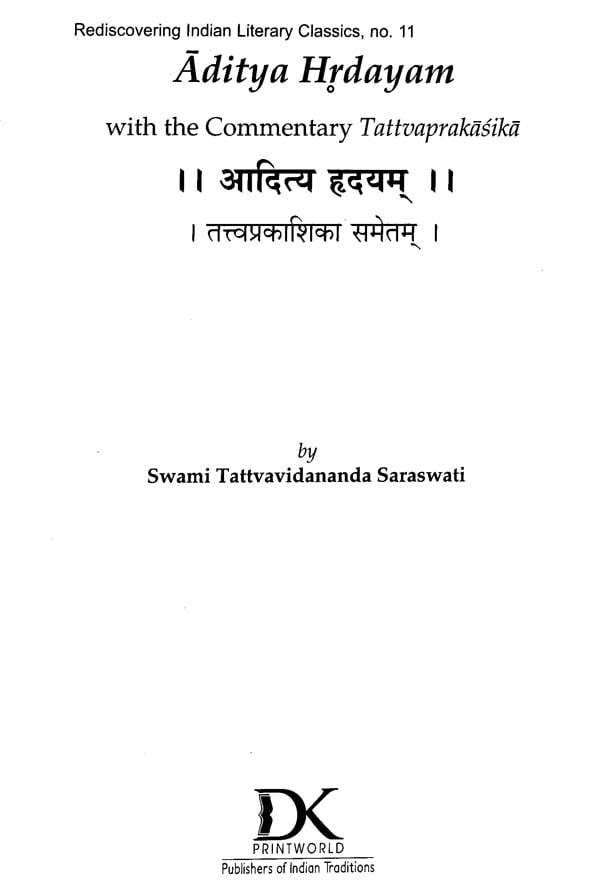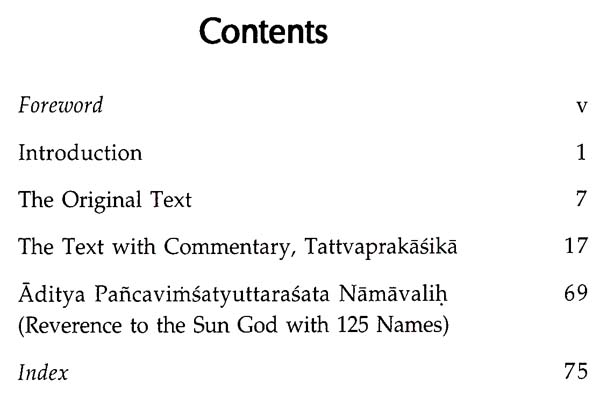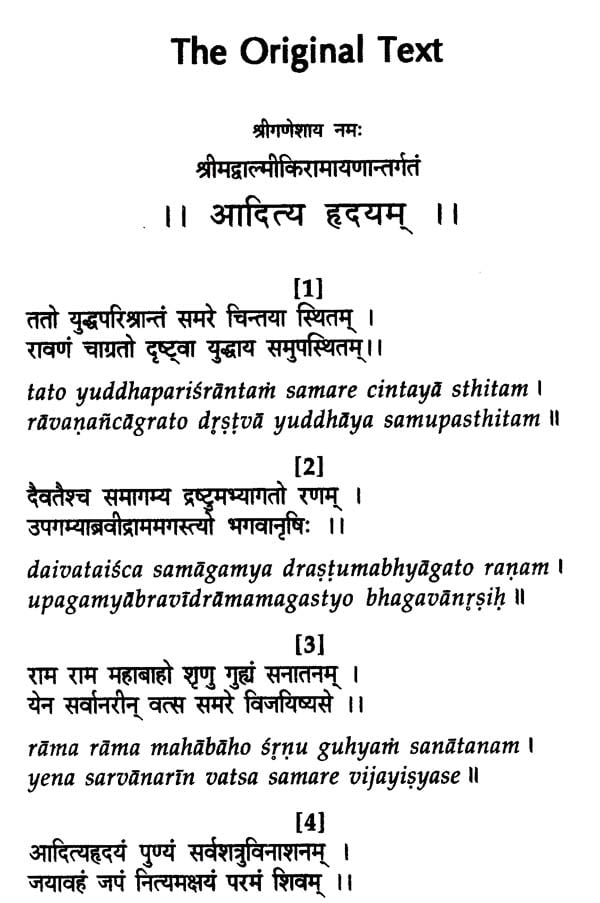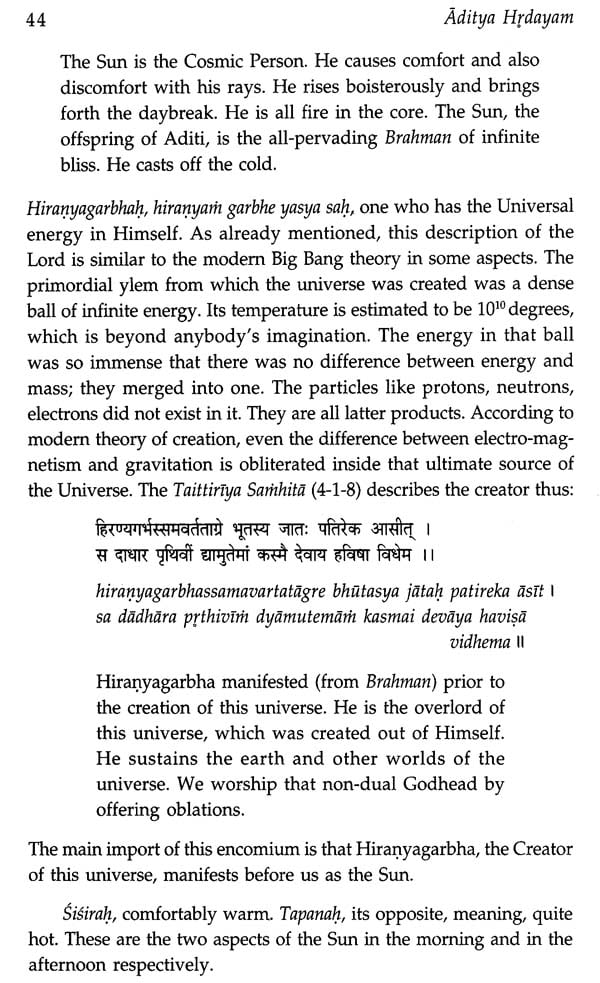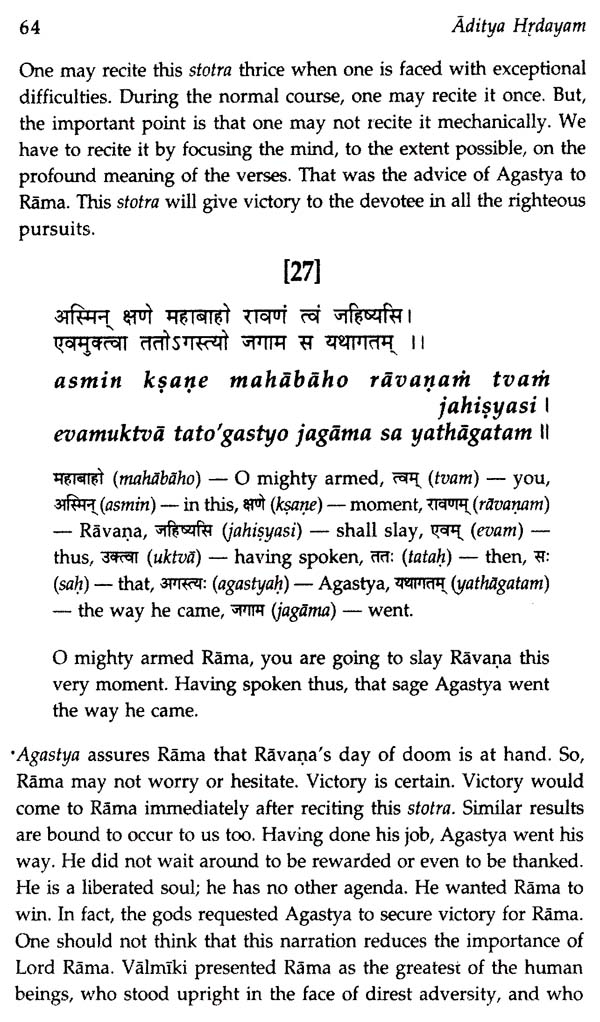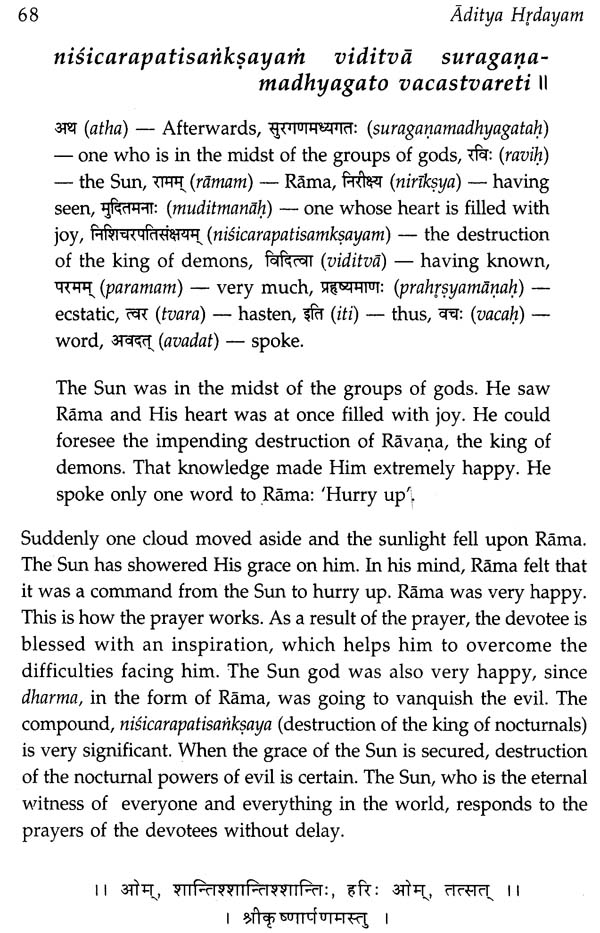
Aditya Hrdayam
Book Specification
| Item Code: | NAV897 |
| Author: | Swami Tattvavidananda Saraswati |
| Publisher: | D. K. Printworld Pvt. Ltd. |
| Language: | English and Sanskrit |
| Edition: | 2020 |
| ISBN: | 9788124602317 |
| Pages: | 77 |
| Cover: | PAPERBACK |
| Other Details | 8.50 X 5.50 inch |
| Weight | 130 gm |
Book Description
The book presents the original Sanskrit mantras of the 'Aditya Hrdayam' along with their Roman transliteration and lucid English translation. The verses are accompanied by detailed annotations that describe every term, concept and idea with great clarity. The commentary, easy to follow and fluent in flow, explores the secret of the eternal stotra, Aditya Hrdayam conveyed by Sage Agastya to Lord Rama using which the latter emerged victorious over Ravana. Aditya Hrdayam is hailed as one of the greatest tributes to the Sun by our ancient sages that provides insights into the importance of the Sun as the creator and sustainer of the Universe, the ultimate source of all wealth. The commentary involves copious references to Taittiriya Samhita, Taittiriya Aranyaka, Taittiriya Upanisad, Chandogya Upanisad, Srimadbhagavadgita, etc., which make it all the more comprehensive and scholarly.
Swami Tattvavidananda Saraswati, a Sannyasi-scholar, is a noted teacher of the Vedas, the Vedantic literature, the epics and Sanskrit literature. His discourses and courses conducted in gurukulas have been a source of inspiration to national and international audiences. An author of several works on Hindu religion and philosophy, he has been honoured with the title of 'Vidya Nidhi' by Sri Sankaracharya of Pushpagiri Matha.
Pujya Swami Tattvavidanada Saraswati started teaching in the Gurukulam in the fall of 1998. He has been a long-time student of Pujya Swami Dayananda Saraswati and has been teaching Vedanta in India for a number of years. The two most striking things about Swamiji are his clarity of thought and his wealth of knowledge. Swamiji hails from a family of Vedantic and Vedic scholars and is a great scholar himself. He has a Ph.D. in Chemistry and worked as a scientist in India. He also has a Ph.D. in Sanskrit. He is a walking encyclopedia of Vedanta, the Vedas and the Puranas. Like Pujya Swami Dayananda he uses simple and easy-to-understand words to impart complex concepts to the modern mind.
Many devotees like me chant mantras like Aditya Hrdayam without fully understanding their meaning or significance.
THE text Aditya Hrdayam is a part of the immortal epic , srimadramayanam authored by Adikavi Valmiki. In the Vedic culture, worshipping of Isvara -isvaropasana - is very characteristic and unique, and probably slightly different from what we come across today in the Hindu society. Here, Isvara is worshipped in a form, which is readily available for our perception as part of the Nature before us. For example, isvara is worshipped as the Fire. The Rgveda, the foremost of the Vedas, starts with the invocation: agnimide purohitam I I praise the glory of Agni, who is the foremost as a benefactor.
Here Agni is isvara. Aurobindo explained the word Agni as the Divine Will and Wisdom. In the Vedic culture, fire is universally taken as the symbol of isvara. We relate to, or we worship isvara in the form of fire. Another such altar described in the Vedas is the Sun.
In the earlier times, the investiture with the sacred thread, teaching of Vedas and recitation of the Gayatri was allowed (desired) for the women.
Sitadevi was described by Valmiki as performing the sandhya meditation in the Asoka forest, where she was held captive by Ravana. One should relate to isvara every morning at the time of sunrise, irrespective of the situation in which one finds oneself, whether one is in prosperity or in adversity. This daily worship called sandhya-vandana should not be dispensed with.
The Cosmic Person (Isvara), who brought out this universe out of Himself, is often called in the Vedic literature by the name Hiranyagarbha from the standpoint of the Universal Power and Omniscience. In the Puranic literature, Isvara is referred to as Visnu (one who pervades all) or as diva (the auspicious). That Hiranyagarbha is worshipped in the altar of the Sun, because, in this Solar system where we live, it is the Sun that is the source of all energy, all activities and all life. That Isvara, who is manifest in the form of the Sun before us, is also present in us in the form of atman, the Awareness, thereby illuminating our thoughts, and making all varieties of knowing possible. If that awareness were not to manifest, then there would have been no faculty of thinking. The power of thinking (dhi Sakti) is the basis of human existence. A human being is nothing but his ideas and understanding (buddhi). The difference between a person in coma and a normal, person is the power of thinking alone. In fact, all the metabolic processes such as regulation of body temperature, heartbeat, etc., go on even for a comatose person. The only difference is that his intellect is not functioning. That is also the reason why he is not moving or doing anything. We think that the buddhi is present inside the body. But that is wrong. The body exists in the buddhi, and that buddhi exists in "Oman, the Awareness, which is that para-Brahman. That Awareness (caitanya) manifesting in this body-mind-sense complex in the form of consciousness, inspiring the buddhi-vrttis, is also present before us in the form of the solar orb, Hiranyagarbha. That is the meaning of Gayatri mantra in a nutshell.
**Contents and Sample Pages**
